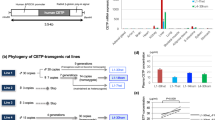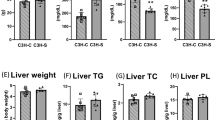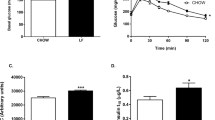Abstract
Coronary heart disease, hypertension, non-insulin-dependent diabetes and obesity are major causes of ill health in industrial societies. Disturbances of carbohydrate and lipid metabolism are a common feature of these disorders1–9. The bases for these disturbances and their roles in disease pathogenesis are poorly understood. The spontaneously hypertensive rat (SHR), a widely used animal model of essential hypertension10, has a global defect in insulin action on glucose metabolism and shows reduced catecholamine action on lipolysis in fat cells11–14. In our study we used cellular defects in carbohydrate and lipid metabolism to dissect the genetics of defective insulin and catecholamine action in the SHR strain. In a genome screen for loci linked to insulin and catecholamine action, we identified two quantitative trait loci (QTLs) for defective insulin action, on chromosomes 4 and 12. We found that the major (and perhaps only) genetic determinant of defective control of lipolysis in SHR maps to the same region of chromosome 4. These linkage results were ascertained in at least two independent crosses. As the SHR strain manifests many of the defining features of human metabolic Syndrome X, in which hypertension associates with insulin resistance, dyslipidaemia and abdominal obesity, the identification of genes for defective insulin and catecholamine action in SHR may facilitate gene identification in this syndrome and in related human conditions, such as type-2 diabetes and familial combined hyperlipidaemia.
This is a preview of subscription content, access via your institution
Access options
Subscribe to this journal
Receive 12 print issues and online access
$209.00 per year
only $17.42 per issue
Buy this article
- Purchase on Springer Link
- Instant access to full article PDF
Prices may be subject to local taxes which are calculated during checkout
Similar content being viewed by others
References
Evans, D.J., Murray, R. & Kissebah, A.H. Relationship between skeletal muscle insulin resistance, insulin-mediated glucose disposal and insulin binding. Effects of obesity and body fat topography. J. Clin. Invest. 74, 1515–1525 (1984).
Ferrannini, E. et al. Insulin resistance in essential hypertension. N. Engl. J. Med. 317, 350–357 (1987).
Reaven, G.M. Banting Lecture 1988. Role of insulin resistance in human disease. Diabetes 37, 1595–1607 (1988).
Hunt, S.C. et al. Apolipoprotein, low density lipoprotein subfraction, and insulin associations with familial combined hyperlipidemia: study of Utah patients with familial dyslipidemic hypertension. Arteriosclerosis 9, 335–344 (1989).
Kaplan, N.M. The deadly quartet: upper body obesity, glucose intolerance, hypertriglyceridemia, and hypertension. Arch. Intern. Med. 149, 1514–1520 (1989).
McGarry, J.D. What if Minkowski had been ageusic? An alternative angle on diabetes. Science 258, 766–770 (1992).
Cohen, B., Novick, D. & Rubinstein, M. Modulation of insulin activities by leptin. Science 274, 1185–1188 (1996).
Polonsky, K.S., Sturis, J. & Bell, G.I. Non-insulin-dependent diabetes mellitus - a genetically programmed failure of the beta cell to compensate for insulin resistance. N. Engl. J. Med. 334, 777–783 (1996).
Reaven, G.M. Lithell, H. & Landsberg, L. Hypertension and associated metabolic abnormalities - the role of insulin resistance and the sympathoadrenal system. N. Engl. J. Med. 334, 374–381 (1996).
Yamori, Y. Development of the spontaneously hypertensive rat (SHR) and of various spontaneous rat models, and their implications. in Handbook of Hypertension, Vol 4. Experimental and Genetic Models of Hypertension (ed. de Jong, W.) 224–239 (Elsevier Science Publishers, New York, 1984).
Chiappe de Cingolani, G.E. Adipocyte responsiveness to norepinephrine in spontaneously hypertensive rats. Metabolism 37, 318–322 (1988).
Reaven, G.M., Chang, H., Hoffman, B.B. & Azhar, S. Resistance to insulin-stimulated glucose uptake in adipocytes from spontaneously hypertensive rats. Diabetes 38, 1155–1160 (1989).
Rao, R.H. Insulin resistance in spontaneously hypertensive rats: difference in interpretation based on insulin infusion rate or on plasma insulin in glucose clamp studies. Diabetes 42, 1364–1371 (1993).
Paternostro, G., Clarke, K., Heath, J., Seymour, A.M. & Radda, G.K. Decreased GLUT-4 mRNA content and insulin-sensitive deoxyglucose uptake show insulin resistance in the hypertensive rat heart. Cardiovasc. Res. 30, 205–211 (1995).
Pravenec, M., Klir, P., Kren, V., Zicha, J. & Kunes, J. An analysis of spontaneous hypertension in spontaneously hypertensive rats by means of new recombinant inbred strains. Hypertens. 7, 217–221 (1989).
Pravenec, M. et al. Mapping of quantitative trait loci for blood pressure and cardiac mass in the rat by genome scanning of recombinant inbred strains. J. Clin. Invest. 96, 1973–1978 (1995).
Bottger, A. et al. Quantitative trait loci influencing cholesterol and phospholipid phenotypes map to chromosomes that contain genes regulating blood pressure in the spontaneously hypertensive rat. J. Clin. Invest. 98, 856–862 (1996).
Pravenec, M. et al. A genetic linkage map of the rat derived from recombinant inbred strains. Mamm. Genome 7, 117–127 (1996).
Goldmuntz, E.A. et al. Genetic map of 16 polymorphic markers forming three linkage groups assigned to rat Chromosome 4. Mamm. Genome 6, 459–463 (1995).
Jacob, H.J. et al. A genetic linkage map of the laboratory rat, flattus norvegicus. Nature Genet. 9, 63–69 (1995).
Lander, E. & Kruglyak, L. Genetic dissection of complex traits: guidelines for interpreting and reporting linkage results. Nature Genet. 11, 241–247 (1995).
Hilbert, P. et al. Chromosomal mapping of two genetic loci associated with blood-pressure regulation in hereditary hypertensive rats. Nature 353, 521–529 (1991).
Jacob, H.J. et al. Genetic mapping of a gene causing hypertension in the stroke-prone spontaneously hypertensive rat. Cell 67, 213–224 (1991).
Galli, J. et al. Genetic analysis of non-insulin dependent diabetes mellitus in the GK rat. Nature Genet. 12, 31–37 (1996).
Gauguier, D. et al. Chromosomal mapping of genetic loci associated with non-insulin dependent diabetes in the GK rat. Nature Genet. 12, 38–43 (1996).
Hubner, N. et al. The gene encoding endothelial nitric oxide synthase, Nos3, maps to rat chromosome 4. Mamm. Genome 6, 758–759 (1995).
Beckers, M.C. et al. A high resolution map of mouse chromosome 5 encompassing the reeler (rl) locus. Genomics 23, 685–690 (1994).
Riess, O. et al. Precise mapping of the brain alpha 2-adrenergic receptor gene within chromosome 4p16. Genomics 19, 298–302 (1994).
Klocke, R. et al. Chromosomal mapping in the mouse of eight K(+)-channel genes representing the four Shaker-like subfamilies Shaker, Shab, Shaw, and Shal. Genomics 18, 568–574 (1993).
Dohi, Y., Kojima, M. & Sato, K. Endothelial modulation of contractile responses in arteries from hypertensive rats. Hypertension 28, 732–737 (1996).
Scherrer, U., Randin, D., Vollenweider, P., Vollenweider, L. & Nicod, P. Nitric oxide release accounts for insulin's vascular effects in humans. J. Clin. Invest. 94, 2511–2515 (1994).
Huang, P.L. et al. Hypertension in mice lacking the gene for endothelial nitric oxide synthase. Nature 377, 239–242 (1995).
McLaughlin, M.G., Printz, M.P. & Jacob, H.J. Genetic dissection of cardiovascular startle response and hypertension in the spontaneously hypertensive rat. Circulation 92, 1–554 (1995).
Gordon, R.D. Heterogeneous hypertension. Nature Genet. 11, 6–9 (1995).
Scott, J. New chapter for the fat controller. Nature 379, 113–114 (1996).
Todd, J.A. Transcribing diabetes. Nature 384, 407–408 (1996).
Reaven, G.M., Hollenbeck, C., Jeng, C.-Y., Wu, M.S. & Ida Chen, Y.-D. Measurement of plasma glucose, free fatty acid, lactate, and insulin for 24 h in patients with NIDDM. Diabetes 37, 1020–1024 (1988).
Martin, L.L. & Jensen, M.D. Effects of body fat distribution on regional lipolysis in obesity. J Clin. Invest. 88, 609–613 (1991).
Castro Cabezas, M. et al. Impaired fatty acid metabolism in familial combined hyperlipidemia: a mechanism associating apolipoprotein B overproduction and insulin resistance. J Clin. Invest. 92, 160–168 (1993).
Reynisdottir, S., Wahrenberg, H., Carlstrom, K., Rossner, S. & Arner, P. Catecholamine resistance in fat cells of women with upper-body obesity due to decreased expression of beta2-adrenoceptors. Diabetologia 37, 428–435 (1994).
Reynisdottir, S., Eriksson, M., Angelin, B. & Arner, P. Impaired activation of adipocyte lipolysis in familial combined hyperlipidemia. J Clin. Invest. 95, 2161–2169 (1995).
Aitman, T.J. et al. Defects of insulin action on fatty acid and carbohydrate metabolism in familial combined hyperlipidemia. Arterioscler. Thromb. Vase. Biol. 17, 748–754 (1997).
Rodbell, M. Metabolism of isolated fat cells. I. Effects of hormones on glucose metabolism and lipolysis. J Biol. Chem. 239, 375–380 (1964).
Simon, J.S. et al. Chromosomal mapping of the rat Slc4a family of anion exchanger genes, Ae1, Ae2, and Ae3. Mamm. Genome 7, 380–382 (1996).
Paterson, A.H. et al. Resolution of quantitative traits into Mendelian factors by using a complete linkage map of restriction fragment length polymorphisms. Nature 335, 721–726 (1988).
Belknap, J.K., Mitchell, S.R. OTool, L.A., Helms, M.L & Crabbe, J.C. Type I and type II error rates for quantitative trait loci (QTL) mapping studies using recombinant inbred mouse strains. Behav. Genet. 26, 149–160 (1996).
Kirkwood, T.B.L. Geometric means and measures of dispersion. Biometrics 35, 908–909 (1979).
Author information
Authors and Affiliations
Corresponding author
Rights and permissions
About this article
Cite this article
Aitman, T., Gotoda, T., Evans, A. et al. Quantitative trait loci for cellular defects in glucose and fatty acid metabolism in hypertensive rats. Nat Genet 16, 197–201 (1997). https://doi.org/10.1038/ng0697-197
Received:
Accepted:
Issue Date:
DOI: https://doi.org/10.1038/ng0697-197
This article is cited by
-
Transgenic rescue of defective Cd36 enhances myocardial adenylyl cyclase signaling in spontaneously hypertensive rats
Pflügers Archiv - European Journal of Physiology (2013)
-
CD36-deficient congenic strains show improved glucose tolerance and distinct shifts in metabolic and transcriptomic profiles
Heredity (2012)
-
Regulation of blood pressure and glucose metabolism induced by L-tryptophan in stroke-prone spontaneously hypertensive rats
Nutrition & Metabolism (2011)
-
Recent Advances in Genetics of the Spontaneously Hypertensive Rat
Current Hypertension Reports (2010)
-
Progress and prospects in rat genetics: a community view
Nature Genetics (2008)



